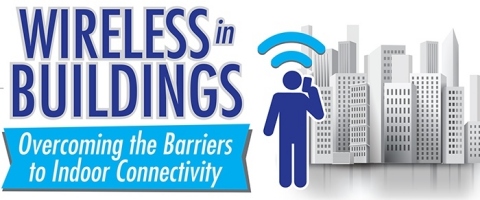HICKORY, N.C.--(BUSINESS WIRE)--There are an estimated two billion smartphone users globally, with an estimated 80 percent of mobile traffic originating or terminating within a building.
With that in mind, it is critical that residents, visitors and workers have access to strong and reliable cellular coverage in order to properly make use of their mobile devices. Despite this, only an estimated two percent of commercial buildings have dedicated technology to ensure strong and reliable mobile coverage and capacity indoors.
The second installment of a new global study, commissioned by global network infrastructure leader CommScope and carried out by Coleman Parkes, surveyed the professionals who design and manage such buildings – including building managers, facilities managers, real estate managers and architects - to explore this untapped business opportunity and consumer need.
Connectivity benefits
Survey respondents asserted that indoor wireless coverage could increase a property’s value by 28% on average, meaning that a $2.5 million office building could be worth $700,000 more with a dedicated indoor cellular system.
Respondents also cited benefits for the enterprise tenant, including an increase in workforce productivity (77%), supporting the recruitment of more talented individuals (46%) and even attracting more visitors (39%). Two-thirds of respondents also rated indoor wireless connectivity as ‘essential’ for employees.
Challenges to overcome
Providing mobile coverage to users within larger and more complex buildings can require investment in dedicated technology. However, there are clearly concerns around who is responsible for the provision and management of this infrastructure.
When asked who is responsible for providing cellular coverage in a building:
- Only one in five (22%) thought building managers should ensure mobile coverage
- Over a third (35%) pointed to network operators
- A quarter (26%) placed emphasis on IT managers
When asked what challenges prevented those from providing dedicated wireless networks indoors, they identified these three top roadblocks:
- The cost of the network (35%)
- The complexity of the technology (19%)
- A lack of skilled workers to manage it (11%)
Dr. Ispran Kandasamy, global leader, Building Solutions, CommScope, believes building professionals should take greater responsibility.
“People are obsessed with their mobile phones and see indoor wireless coverage as important as having access to water and electricity,” said Kandasamy. “The time has come for building professionals to step forward and take ownership for connecting their tenants to mobile networks.
“While there are clearly concerns around the cost and complexity of the technology, building owners must acknowledge that ignoring this issue could result in more costly work in the future. Engaging with architects, facilities managers and enterprises at an early stage will ultimately save money – as well as providing an enhanced user experience.
“Only by taking the lead will building owners be able to provide much needed connectivity in their properties.”
This is the second installment of CommScope’s research into the building industry’s attitudes towards the provision of indoor mobile coverage. CommScope will launch a comprehensive report, with an analysis of the findings and recommendations to the industry, on March 7, 2016.
To pre-register for an early copy of the report and download the Executive Summary, please visit: http://www.commscope.com/IBW-Survey-Report-2016/
Infographic:
Wireless in Buildings: Overcoming the Barriers to Indoor Connectivity
Related Press Release:
Related Blog Posts:
The 3 Most Common Misconceptions about Digital DAS
DAS as a Prelude to the Future of Networking
What Does a DAS Cost for an Enterprise? It Depends!
Methodology:
Coleman Parkes interviewed 600 building managers, facilities managers, real estate managers and architects across the US and Europe, with 300 respondents in the US and 100 in each of UK, France and Germany. The interviews took place in August and September 2015.
About CommScope:
CommScope (NASDAQ: COMM) helps companies around the world design, build and manage their wired and wireless networks. Our vast portfolio of network infrastructure includes some of the world’s most robust and innovative wireless and fibre optic solutions. Our talented and experienced global team is driven to help customers increase bandwidth; maximise existing capacity; improve network performance and availability; increase energy efficiency; and simplify technology migration. You will find our solutions in the largest buildings, venues and outdoor spaces; in data centres and buildings of all shapes, sizes and complexity; at wireless cell sites; in telecom central offices and cable headends; in FTTx deployments; and in airports, trains, and tunnels. Vital networks around the world run on CommScope solutions.
Follow us on Twitter and LinkedIn and like us on Facebook.
Sign up for our press releases and blog posts.
This press release includes forward-looking statements that are based on information currently available to management, management’s beliefs, as well as on a number of assumptions concerning future events. Forward-looking statements are not a guarantee of performance and are subject to a number of uncertainties and other factors, which could cause the actual results to differ materially from those currently expected. In providing forward-looking statements, the company does not intend, and is not undertaking any obligation or duty, to update these statements as a result of new information, future events or otherwise.




